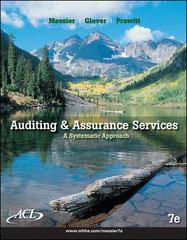Question
Question 2 Smith Equipment Industries (Smith) produced custom-designed machinery for a long-time customer. The direct cost to produce the machinery was $2.8 million. Smith sold
Question 2 Smith Equipment Industries (Smith) produced custom-designed machinery for a long-time customer. The direct cost to produce the machinery was $2.8 million. Smith sold the equipment to the customer for $4.0 million. The machinery was delivered, installed, and tested during September 2016. At the end of September, the customer declared satisfaction with the machinery and signed a formal declaration of acceptance. Smith guaranteed the equipment for a full two years after acceptance, agreeing to correct any defects or operational problems that might occur before September 30, 2018.
At the time of sale, Smiths management estimated that the eventual warranty cost would be no more than $200,000, since Smith had considerable experience with this general type of machinery. Subsequent experience was as follows:
a. Repair costs during the remainder of 2016 amounted to $50,000.
b. At the end of 2016, Smiths managers decided that the total warranty cost might be as much as $260,000 by the end of the warranty period.
c. During 2017, total warranty costs amounted to $80,000.
d. At the end of 2017, management revised their estimate of remaining warranty cost to just $40,000.
e. Additional warranty costs during 2018 (ie up to the end of the warranty period) were $30,000.
Required: Prepare the entries concerning the sale and the warranty that the company would make from September 30, 2016 through September 30, 2018 under each of the following two assumptions:
1. Assume that warranty cost is in the form of an insurance (cost deferral method)
2. Assume instead that Smith also sells the warranty as a separate service. The total contract is still for $4 million. The stand-alone value of the machinery and warranty are $300,000 and $3,800,000 respectively. (revenue deferral method). Round your percentage to one decimal, where appropriate.
Step by Step Solution
There are 3 Steps involved in it
Step: 1

Get Instant Access to Expert-Tailored Solutions
See step-by-step solutions with expert insights and AI powered tools for academic success
Step: 2

Step: 3

Ace Your Homework with AI
Get the answers you need in no time with our AI-driven, step-by-step assistance
Get Started


